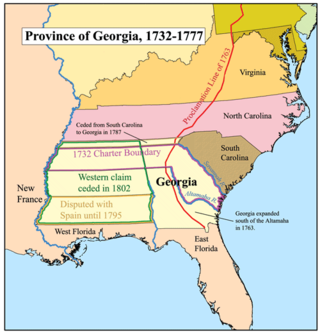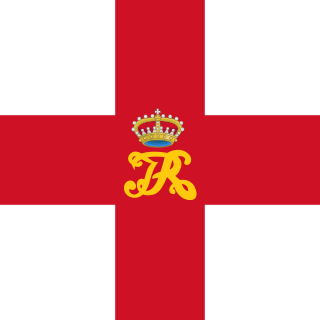
The Thirteen Colonies were a group of British colonies on the Atlantic coast of North America founded in the 17th and 18th centuries. The American Enlightenment led these colonies to the American Revolutionary War. They declared independence as the United States of America in July 1776, which was achieved by 1783 under the Treaty of Paris.

The Massachusetts Bay Colony (1628–1691), more formally the Colony of Massachusetts Bay, was an English settlement on the east coast of North America around the Massachusetts Bay, one of the several colonies later reorganized as the Province of Massachusetts Bay. The lands of the settlement were in southern New England, with initial settlements on two natural harbors and surrounding land about 15.4 miles (24.8 km) apart—the areas around Salem and Boston, north of the previously established Plymouth Colony. The territory nominally administered by the Massachusetts Bay Colony covered much of central New England, including portions of Massachusetts, Maine, New Hampshire, and Connecticut.
This section of the timeline of United States history concerns events from before the lead up to the American Revolution.

The Southern Colonies within British America consisted of the Province of Maryland, the Colony of Virginia, the Province of Carolina, and the Province of Georgia. In 1763, the newly created colonies of East Florida and West Florida would be added to the Southern Colonies by Great Britain until the Spanish Empire took back Florida. These colonies were the historical core of what would become the Southern United States, or "Dixie". They were located south of the Middle Colonies, albeit Virginia and Maryland were also called the Chesapeake Colonies.
The Southern Colonies were overwhelmingly rural, which made slavery and indentured servitude highly used. During a series of civil unrest, Bacon's Rebellion shaped the way that servitude and slavery worked in the South. After a series of attacks on the Susquehannock, attacks that were ensued after the group of natives burnt one of Bacon's farms, Bacon's arrest, along with other arrest warrants, were issued by Governor Berkely, for attacking the natives without his permission. Bacon avoided detainment, though, and then burnt Jamestown, in opposition of the governor previously denying him land in fear of native attacks, however Bacon hadn't believe his policies were entirely conventional, saying that they didn't ensure protection to the English settlers, as well as the exclusion of Bacon from Berkeley's social clubs and friend groups. The rebellion dissolved sometime in 1676, following Charles II's initial sending of troops to restore order in the colony. This rebellion influenced the view of the Africans, helping create a completely African servitude and workforce in the Chesapeake Colonies, alleviating primarily White servitude, a working-class that could be repugnant at times through disobedience and mischief. This also helped racial superiority in White regions, helping the poor White and wealthy White people, respectively, feel almost equal. It diminished alliances between White and Black people, happened in Bacon's Rebellion.
The colonies developed prosperous economies based on the cultivation of cash crops, such as tobacco, indigo, and rice. An effect of the cultivation of these crops was the presence of slavery in significantly higher proportions than in other parts of British America.

The Province of Maryland was an English and later British colony in North America that existed from 1632 until 1776, when it joined the other twelve of the Thirteen Colonies in rebellion against Great Britain and became the U.S. state of Maryland. Its first settlement and capital was St. Mary's City, in the southern end of St. Mary's County, which is a peninsula in the Chesapeake Bay and is also bordered by four tidal rivers.

The Colony of Rhode Island and Providence Plantations was one of the original Thirteen Colonies established on the east coast of America, bordering the Atlantic Ocean. It was founded by Roger Williams. It was an English colony from 1636 until 1707, and then a colony of Great Britain until the American Revolution in 1776, when it became the State of Rhode Island and Providence Plantations.

The Province of Carolina was a province of the Kingdom of England (1663–1707) and later the Kingdom of Great Britain (1707–1712) that existed in North America and the Caribbean from 1663 until partitioned into North and South on January 24, 1712. It consisted of all or parts of present-day Alabama, Florida, Georgia, Mississippi, North Carolina, South Carolina, and Tennessee.

John Clarke was a physician, Baptist minister, co-founder of the Colony of Rhode Island and Providence Plantations, author of its influential charter, and a leading advocate of religious freedom in America.

The Dominion of New England in America (1686–1689) was an administrative union of English colonies covering all of New England and the Mid-Atlantic Colonies, with the exception of the Delaware Colony and the Province of Pennsylvania. The region's political structure was one of centralized control similar to the model used by the Spanish monarchy under the Viceroyalty of New Spain. The dominion was unacceptable to most colonists because they deeply resented being stripped of their rights and having their colonial charters revoked. Governor Edmund Andros tried to make legal and structural changes, but most of these were undone and the Dominion was overthrown as soon as word was received that King James II had left the throne in England. One notable change was the forced introduction of the Church of England into Massachusetts, whose Puritan leaders had previously refused to allow it any sort of foothold.

William Claiborne also, spelled Cleyburne was an English pioneer, surveyor, and an early settler in the colonies/provinces of Virginia and Maryland and around the Chesapeake Bay. Claiborne became a wealthy merchant and planter, as well as a major political figure in the mid-Atlantic colonies. He featured in disputes between the colonists of Virginia and the later settling of Maryland, partly because of his earlier trading post on Kent Island in the mid-way of the Chesapeake Bay, which provoked the first naval military battles in North American waters. Claiborne repeatedly attempted and failed to regain Kent Island from the Maryland Calverts, sometimes by force of arms, after its inclusion in the lands that were granted by a 1632 Royal Charter to the Calvert family. Kent Island had become Maryland territory after the surrounding lands were granted to Sir George Calvert, first Baron and Lord Baltimore (1579–1632) by the reigning King of England, Charles I.

A proprietary colony was a type of colonial administration in English America during the 17th century, and in the East Indies up to the 1850s. In the English overseas possessions, all land belonged to the Crown, which held ultimate authority over their management. All English colonial territories were partitioned by the Crown via royal charters into one of three types: proprietary, royal, or covenant. Under the proprietary system, individuals or companies were granted commercial charters by the Crown to establish overseas colonies. These proprietors were then granted the authority to select the governors and other officials in the colony.
A lord proprietor is a person granted a royal charter for the establishment and government of an English colony in the 17th century. The plural of the term is "lords proprietors" or "lords proprietary".

The colonial period of South Carolina saw the exploration and colonization of the region by European colonists during the early modern period, eventually resulting in the establishment of the Province of Carolina by English settlers in 1663, which was then divided to create the Province of South Carolina in 1712. European settlement in the region of modern-day South Carolina began on a large scale after 1651, when frontiersmen from the English colony of Virginia began to settle in the northern half of the region, while the southern half saw the immigration of plantation owners from Barbados, who established slave plantations which cultivated cash crops such as tobacco, cotton, rice and indigo.

The Fundamental Constitutions of Carolina were adopted on March 1, 1669 by the eight Lords Proprietors of the Province of Carolina, which included most of the land between what is now Virginia and Florida. It replaced the Charter of Carolina and the Concessions and Agreements of the Lords Proprietors of the Province of Carolina (1665). The date March 1, 1669 was the date that proprietors confirmed the Constitutions and sent them to the Colony, but later on two other versions were introduced in 1682 and in 1698. Moreover, the proprietors suspended the Constitutions in 1690. Despite the claims of proprietors on the valid version of the Constitution, the colonists officially recognized the July 21, 1669 version, claiming that six proprietors had sealed the Constitutions as "the unalterable form and rule of Government forever" on that date. The earliest draft of this version in manuscript is believed to be the one found at Columbia, South Carolina archives.
A charter is a document that gives colonies the legal rights to exist. Charters can bestow certain rights on a town, city, university, or other institution.
Charter colony is one of three classes of colonial government established in the 17th century English colonies in North America, the other classes being proprietary colony and royal colony. These colonies were operated under a corporate charter given by the crown. The colonies of Virginia, Rhode Island, Connecticut, and Massachusetts Bay were at one time or another charter colonies. The crown might revoke a charter and convert the colony into a crown colony. In a charter colony, Britain granted a charter to the colonial government establishing the rules under which the colony was to be governed. The charters of Rhode Island and Connecticut granted the colonists significantly more political liberty than other colonies. Rhode Island and Connecticut continued to use their colonial charters as their State constitutions after the American Revolution.

Benedict Arnold was president and then governor of the Colony of Rhode Island and Providence Plantations, serving for a total of 11 years in these roles. He was born and raised in the town of Ilchester, Somerset, England, likely attending school in Limington nearby. In 1635 at age 19, he accompanied his parents, siblings, and other family members on a voyage from England to New England where they first settled in Hingham in the Massachusetts Bay Colony. In less than a year, they moved to Providence Plantation at the head of the Narragansett Bay at the request of Roger Williams. In about 1638, they moved once again about five miles (8 km) south to the Pawtuxet River, settling on the north side at a place commonly called Pawtuxet. Here they had serious disputes with their neighbors, particularly Samuel Gorton, and they put themselves and their lands under the jurisdiction of Massachusetts, a situation which lasted for 16 years.

The English overseas possessions, also known as the English colonial empire, comprised a variety of overseas territories that were colonised, conquered, or otherwise acquired by the former Kingdom of England during the centuries before the Acts of Union of 1707 between the Kingdom of England and the Kingdom of Scotland created the Kingdom of Great Britain. The many English possessions then became the foundation of the British Empire and its fast-growing naval and mercantile power, which until then had yet to overtake those of the Dutch Republic, the Kingdom of Portugal, and the Crown of Castile.

The Grand Model was a utopian plan for the Province of Carolina, founded in 1670. It consisted of a constitution coupled with a settlement and development plan for the colony. The former was titled the Fundamental Constitutions of Carolina. The word "constitutions" was synonymous with "articles." The document was composed of 120 constitutions, or articles. The settlement and development plan for the colony consisted of several documents, or "instructions," for guiding town and regional planning as well as economic development.











